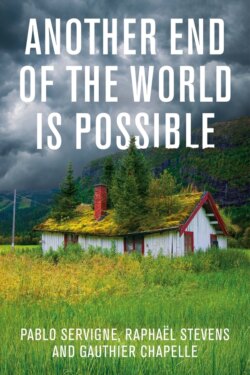Читать книгу Another End of the World is Possible - Pablo Servigne - Страница 16
Notes
Оглавление1 1. Kevin Anderson and Alice Bows, ‘Beyond “dangerous” climate change: emission scenarios for a new world’, Philosophical Transactions of the Royal Society A: Mathematical, Physical and Engineering Sciences 369, 2011: 20–44.
2 2. Ben Chapman, ‘BP and Shell planning for catastrophic 5°C global warming despite publicly backing Paris climate agreement’, The Independent, 27 October 2017.
3 3. Henry Kendall (coordinator), ‘World Scientists’ Warning to Humanity’, Union of Concerned Scientists, 1992.
4 4. Michel Salomon (coordinator), ‘Scientific ecology: The Heidelberg appeal to Heads of States and Governments’, Interdisciplinary Science Reviews 17(4), 1992: 299–300. See also Stéphane Foucart, ‘L’appel d’Heidelberg, une initiative fumeuse’, Le Monde, 16 June 2012.
5 5. William J. Ripple et al., ‘World scientists’ warning to humanity: a second notice’, BioScience 67(12), 2017: 1026–8.
6 6. For an analysis of the phenomenon of ‘gated communities’ in relation to the collapse, see Renaud Duterme, De quoi l’effondrement est-il le nom? La fragmentation du monde (Paris: Les Éditions Utopia, 2016).
7 7. ‘Millionaire migration in 2015’, New World Wealth, March 2016.
8 8. Alec Hogg, ‘As inequality soars, the nervous super rich are already planning their escapes’, The Guardian, 24 January 2015.
9 9. Evan Osnos, ‘Doomsday prep for the super-rich’, The New Yorker, 23 January 2017; Yarra Elmasry, ‘The super-rich are buying luxury apocalypse-safe bunkers for protection against natural disasters and nuclear attack’, The Independent, 10 July 2017; Emmanuèle Peyret and Coralie Schaub, ‘Fin du monde: les survivalistes à bunker ouvert’, Libération, 23 March 2018.
10 10. Bruno Latour, Down to Earth: Politics in the New Climatic Regime (Cambridge: Polity, 2018). Translation by Catherine Porter from Où atterrir? Comment s’orienter en politique (Paris: La Découverte, 2017).
11 11. For example, John Wiseman, The SAS Survival Handbook: The Ultimate Guide to Surviving Anywhere, 3rd edn (New York: HarperCollins, 2014); Bob Arnot and Mark Cohen, Your Survival: The Complete Resource for Disaster Planning and Recovery (Hobart, NY: Hatherleigh Press, 2007); Jim Cobb, Prepper’s Long-Term Survival Guide (Berkeley, CA: Ulysses Press, 2014).
12 12. Bertrand Vidal, Les Représentations collectives de l’événement-catastrophe. Étude sociologique sur les peurs contemporaines, Thèse de doctorat en sociologie, université Montpellier 3, 2012, p. 499.
13 13. Abraham H. Maslow, ‘A theory of human motivation’, Psychological Review 50, 1943: 370–96. This somewhat simplistic theory is used in most business schools.
14 14. Ruth Stégassy, ‘Devenir autonome. Entretien avec Kim Pasche’, broadcast by Terre à Terre, France Culture, 5 September 2015, https://bit.ly/2LU59dG. Developed in Frederika Van Ingen, Sagesses d’ailleurs pour vivre aujourd’hui (Paris: Les Arènes, 2016), p. 37.
15 15. Stégassy, ‘Devenir autonome. Entretien avec Kim Pasche’.
16 16. There are other theories which take account of the complex relations between different fundamental needs. See, for example, that of the Chilean economist Manfred Max-Neef, Development and Human Needs (New York: The Apex Press, 1992).
17 17. Carolyn Baker, Collapsing Consciously (Berkeley, CA: North Atlantic Books, 2013), p. 13.
18 18. Pablo Servigne and Raphaël Stevens, How Everything Can Collapse: A Manual for Our Times (Cambridge: Polity, 2020). Translation by Andrew Brown from Comment tout peut s’effondrer. Petit manuel de collapsologie à l’usage des générations présentes (Paris: Le Seuil, 2015).
19 19. See Clive Hamilton, Requiem for a Species: Why We Resist the Truth About Climate Change (Crows Nest, NSW: Allen and Unwin, 2010); Carolyn Baker, Sacred Demise (Bloomington, IN: iUniverse, 2009); Joanna Macy and Chris Johnstone, Active Hope: How To Face the Mess We’re In Without Going Crazy (Novato, CA: New World Library, 2012).
20 20. Baker, Collapsing Consciously, p. 15.
21 21. See his blog at http://www.paulchefurka.ca/
22 22. This simplified schematic structure is useful for situating ourselves, but we should be aware that the reality can be much more complex and dynamic.
23 23. Paul Chefurka, ‘Climbing the Ladder of Awareness’, 19 October 2012, http://www.paulchefurka.ca/LadderOfAwareness.html, accessed 15 August 2019.
24 24. Ibid.
25 25. Ibid.
26 26. Ibid.
27 27. Adapted from Baruch Spinoza, Ethics, Part III, Preface.
28 28. Dominique Bourg, Une nouvelle Terre (Paris: Desclée De Brouwer, 2018).
29 29. John Michael Greer, ‘Bringing It Down to Earth’, https://carolynbaker.net/2011/11/25/bringing-it-down-to-earth-by-john-michael-greer/, accessed 5 March 2020. Originally posted in Energy Bulletin.
30 30. Ibid. See also John Michael Greer, Ecotechnic Future: Envisioning a Post-Peak World (Gabriola Island, BC: New Society Publishers, 2009).
31 31. Documentary written and directed by Iolande Cadrin-Rossignol, La Terre vue du coeur, distribution Ligne 7, May 2018.
32 32. Baker, Collapsing Consciously, p. 98.
33 33. Latour, Down to Earth, p. 5. I’ve slightly changed Catherine Porter’s translation to avoid losing the ‘earth’ imagery which is important for Servigne et al. (terrestre, territoire, atterrir). – Tr.
